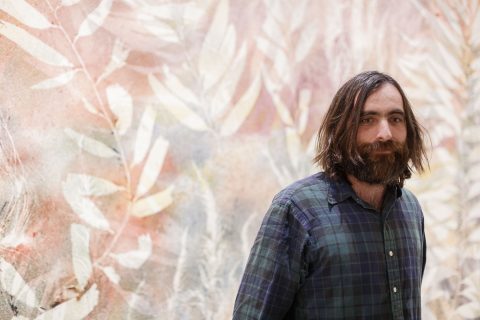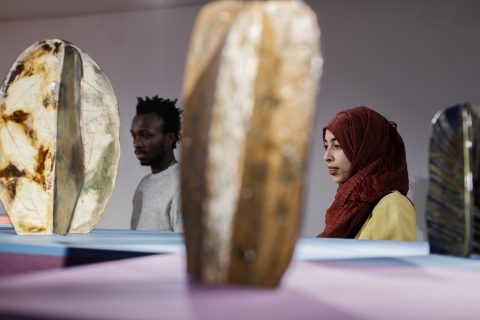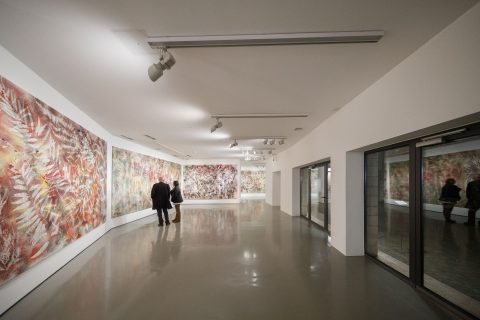Sam Falls’ first institutional exhibition in Europe is an elegiac statement
Sam Falls’ show at Galleria Civica di Trento sets a new dialogue between Minimalism and Nature. But light and life are still leading his artistic research.
- Sam Falls, ‘Nature is the new minimalism’ exhibition view at Galleria Civica Trento
- Sam Falls, ‘Nature is the new minimalism’ exhibition view at Galleria Civica Trento
- Sam Falls, ‘Nature is the new minimalism’ exhibition view at Galleria Civica Trento
- Sam Falls, ‘Nature is the new minimalism’ exhibition view at Galleria Civica Trento
- Sam Falls, ‘Nature is the new minimalism’ exhibition view at Galleria Civica Trento
The first institutional exhibition in Europe by Sam Falls inaugurated last week at the Galleria Civica of Trento, which since a few years has entered into the orbit of MART (Museum of Modern and Contemporary Art of Trento and Rovereto). Falls titled it ‘Nature is the new minimalism’ and like all the exhibitions by Sam Falls we have seen up to now, starting from the one hosted at the little Luce Gallery in Turin back in winter 2012, to arrive, through the two big installations at Art Basel Unlimited (2014 and 2016), to the most recent installation commissioned by the Hammer Museum in Los Angeles (2017/2018), also this new Italian step has a lyrical nature. At this point we came to believe that before being an artist, Falls is a poet, namely the kind of artist creating feelings rather than messages. This is proved once again by the introductory text to the exhibition, that Falls personally wrote, as he generally does on important occasions. In this instance, like in the past, the artist decides to talk about his works by describing the way they were were conceived.
The first image photographically emerging from the canvas is that of the artist who at twilight enters the ocean ‘like a pearl diver’ and questions the abyss he is diving into in order to fulfil the mission he has taken up. He cuts off seaweeds that he will later lay down on the canvas awaiting for him on the sand so that the pigments diluted by the ocean breeze will draw throughout the night their outlines.
‘I was thinking of Pollock’ Falls told us. We met him the day before the opening, when he was adding the finishing touches to the almost installed exhibition. As a matter of fact the body of paintings he is presenting at the Galleria Civica of Trento, like those of Pollock action painting, have no vanishing point and clearly reveals to have been ‘painted’ on the floor, rather than on a surface that stood upright. Like Pollock, and following a need that Falls must have felt since he was superimposing painting marks on photographic images of totemic figures (there he was referring to Paul Cézanne’s Mont Sainte-Victoire), also in these new paintings the Californian artist seeks to give depth to the two-dimensional surface, bringing his ‘imprints’, that at this point we could perhaps call ‘impressions’, into the third dimension; he does so by following a path which, for instance, is contrary to the one taken up by Wade Guyton in 2006, whose aim is rather to flatten the surface as much as possible by working horizontally (‘X’, flames, black paintings, vitrines).
Unlike Pollock, who has always been a painter, Falls moves from Guyton’s research on the expressive potentialities of the printing process, and thus from a logic perhaps more relevant to photography than to painting – the comparison between the two takes place in Zurich, where in 2013 the artists had been exhibited at the same time in the same building – Guyton at the Kunsthalle (with the red ) and Falls at Eva Presenhuber (presenting the rope paintings for the first time). Guyton replaces the brush with the ink-jet printer and starts from a digital source, that is an image or text file. Falls makes a step back, getting rid of the medium and turning directly to the natural elements. At first it was California’s light bleaching the sun umbrella from the Topanga series; the moving blankets marked by pallets; or the varnished metal surfaces of his highly precise metal sculptures, at that time the only rigid ‘structure’ of a work mostly based on the lack of structure. Then water came in, to dissolve the primary pigments (ripe paintings, for instance). And now fire and earth add up, where the ancient technique of ceramics is born of (Falls reminds us that his wife Erin is a ceramist).
The idea that leads the group of ceramic works that Falls presents in Trento doesn’t differ from the one that determined the paintings; also in this case the artist attaches a human experience with a poetical hint. Falls talks about this in the introductory text, when he describes the ‘dirt path’ he walks down with his little son. He ‘thinks quickly’ writes Falls, and so ‘the walk is slow’ (worth to mention the best seller by Daniel Kahnemann, Thinking, fast and sloe, which in the end it’s a work dedicated first and foremost to the human being, then to economics). The process is simple, direct, spontaneous, therefore intimate. ‘The support where the ceramic works stand’ Falls tells us ‘doesn’t have any metal screw. It’s natural-painted wood’. If we go back to the title of the exhibition, the first formal reference we could point out is the furniture pieces designed by Donald Judd. However, someone could also think of the many four-handed works by Martino Gamper and Francis Upritchard, or else, the piece that Carol Bove presented at the Venice Biennal in 2015 – so far the masterpiece of the artist, who has represented Switzerland at the following Biennal, with results not as effective. In all these instances, including Falls’, the continuity between the support and the works is not as relevant as how much the supports are able to turn the sculptures into intimate, rather than public, objects by placing them at eye, ears and stomach level.
There also two sculptures made of neon and paraffin on exhibition. A thin neon tube, whose gas is the most eco-friendly on the market, as Falls reminds us, designs the silhouette of a human figure, which while warming up melts the paraffin. As far as we know this is actually the first time that the human figure appears in Falls’ work, and this could open a further door into the work of an extremely prolific (in a very positive sense) artist. There are then three videos projected in as many rooms which the light turns respectively green, blue and violet. It’s a light which filters from the trees through a painted cloth. It is the same light that has generated the other works, the light that surrounds the poet’s house.
November 25, 2020





